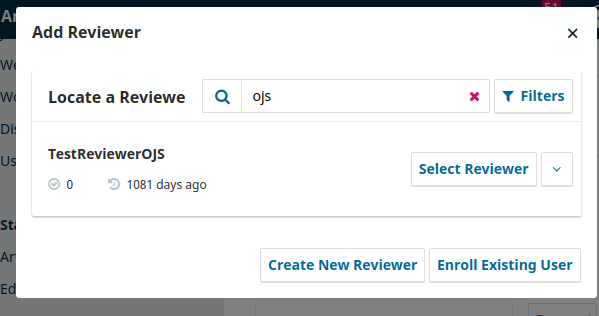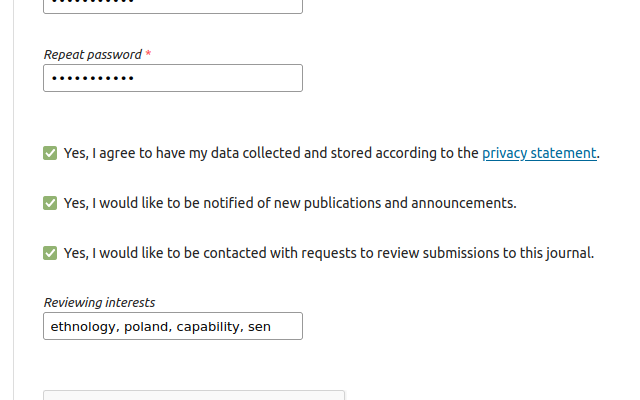OJS - notes for editors and reviewers
Open Journal Systems, also known as OJS, is an open source and free software for the management of peer-reviewed academic journals, created by the Public Knowledge Project, and released under the GNU General Public License. (From Wikipedia)
You can try a demo, download OJS, or access the OJS user guides at the Public Knowledge Project.
This page is a resource for Journal editors and reviewers working with OJS for one of the NomadIT published Journals, or existing or potential NomadIT clients who are considering OJS as a platform for their journal
OJS Peer Review process - background steps
An author submits article
The first step of the publishing process is the submission of a new article. The process follow these steps:
- The author submits their article.
Here is an example of Author Guidelines from Teaching Anthropology Journal - The journal editor receives an email notification
- The editor logs into the journal to view the article
The journal editor makes a decision
At this point, the editor can decide to
- A. reject the article
- B. accept the article in its original form, and send to production
- C. submit the article for review
An editor is assigned
If the article is accepted or sent to review, and editor needs to be assigned for this article. It can be the existing editor, or it can be someone else. The assigned editor will receive an email notification of the assignment
How to find and assign reviewers
The article's editor assigns a reviewer
These are the different ways a reviewer can be assigned
- A. from a list of already registered reviewers - based on disclosed criteria such as review interest, how many reviews have this user has already performed
- B. by enrolling an existing user as a reviewer (so here, the editor could work from a list of users who have already been invited and registered with the journal). Editors find that inviting existing authors who have been published through the journal, often gives a positive result. However, the editor would have to work from a list of authors emails to find them.
- C. by adding a new user and enrolling them as a reviewer (editor will need info such as email, affiliation and reviewer interest)
Please note that all processes which involve registering a new reviewer (B and C above) are manual - meaning they require filling in a registration form either by the editor or by the reviewer. Also, note that the editor needs a potential reviewer's consent before adding them as user of the journal
Note: When registering a new author, editor or reviewer, this new user should also be given the role "reader". When failing to assign the role "reader", the user may have problems accessing the relevant steps of the workflow.

How to self-register as a reviewer
- By default, OJS allows users to self-register as an Author, Reader, or Reviewer.
- When registering with the journal, user needs to tick box "Yes, I would like to be contacted with requests to review submissions to this journal".
- upon ticking this box, the user can input review interests, such as keywords on discipline, topic or geo area.

Accept review invitation and view the article
The reviewer receives an invitation to review the article
This email contains
- The deadline for accepting the invitation
The deadline is set in journal settings Workflow > Settings > Default response deadline - A link to reset password in case user does not have that saved
- Submission URL
(unless this has been set to disabled in workflow settings - The reviewer then clicks on the submission url, and is taken to the Journal's login page
- The reviewer accepts the invitation, and an email is sent the assigned editor.
- Upon acceptance, the reviewer is directed to the Review guidelines if they exist.
Guidelines are extremely helpful and increase the likelihood that the review will be undertaken, especially if the reviewer is inexperienced. Example here: Review guidelines Example from Teaching Anthropology Journal by the RAI
Login problems
The review invitation email contains a link to reset password in case user does not have that saved, which is a likely scenario. This is therefore a common hurdle for accepting and progressing with the review
It also slightly confusing that the review invitation email doesn't contain username, but rather
uses the given
name. This is confusing given that the actual login form requires
username and not email.
This could perhaps be changed in the email templates
The reset password process is a little unusual in OJS - the user will receive 2 emails - one with the reset link and one with the password. This second email also contains the username to be entered on the login form.
Possible complications
Problems which may occur
- The reviewer does not receive email. This can happen with academic servers blocking it, or common providers such as gmail
- The reviewer receives email but does not reply
- The reviewer does not accept invite
- The reviewer wants to accept but cannot log in, gives up.
- The system emails go to university spam folders so reviewers often don't get the email
- People are busy - resulting in a lot of review work falling on the editors themselves
- TIP: inviting previous authors often gives a positive result
Review process
- Select the article to be reviewed
- Accept Review, Continue.
- “Guidelines” step
- “Download & Review the article
Open in Word, and block several selected sentences then select “New Comment“ and add your comments to review the article. - Once done, upload the commented file to "Review files"
- Enter general review comments in the author and editor boxes.
The author and editor will then be notified of the review
The full publishing process
Here is a brief description of the full publishing process, assuming the article is accepted and sent to review.
- The Author submits an article
- The Journal Editor is notified by email
- The Journal Editor clicks on the link in the email to access the new submission
- Here, the editor downloads and reads the article, assigns a different editor or themselves to
the
article - an email goes to the assigned editor
NOTE: When assigning the editor, make sure that the box "Assignment privileges" is NOT ticked, or the reviewer will not be able to make a recommendation, including sending an email to the author requesting revisions. - could find some errors need to be fixed, adds a pre-review discussion which includes the author
- the author receives a notification of this pre-review discussion, with a link to view the submission and the discussion.
- As a result, the author may re-submit or upload a revised version.
- The end result of this stage, is that the article is accepted and sent to review
- The editor assigns a reviewer - this sends an email invite with a link to the article to the reviewer
- the reviewer accepts the review assignment, the editor receives a notification of this.
- The reviewer clicks the link, logs in, downloads the article
- The reviewer adds their review comments in the 2 boxes a) for the author and editor and b) for
the editor.
Note: the author can only see these comments when shared to them by the editor later. - The reviewer makes comments in the article, and uploads this commented version to the review stage under "Review files".
- The editor receives a notification that the review has been submitted.
- The editor clicks on the link in the email to access the review stage of the article, Clicks on "Read review" to see the comments, downloads and reads the article with the reviewers comments.
- The editor then chooses from the dropdown of decisions (in this example agrees that revisions are required) and clicks "confirm".
- The editor then clicks on "Request revisions
- IN the window that opens, the editor can see the email which will go to the author with the request for revisions. This email contains the comments from the reviewer for the author and editor. Here, the editor also selects the review files with the reviewers comments by ticking them. Then the editor clicks "Record Editorial decisions."
- A note about discussions: With review discussion from the reviewer, the editor can click on it and add the author as a participant in "Participants > Edit". In this way, the author will see the comments made by the reviewer, IF the editor chooses to share them with author.
- Another note: When editor shares these comments and files with the author, the reviewer has to be removed as a participant, or it violates blind review. The system will warn the editor about this.
- Now, the author can view comments from the reviewer and download the commented file. IF the editor has attached this file in the review discussion
- The author makes their changes to the file and uploads this file under "Revisions"
- The author may also add a discussion where they detail what has been done
- The editor now receives an email that revised versions has been uploaded by the author
- The editor now receives an email that there is activity in the discussion
- If the author has added a discussion, the editor will receive a separate email about this.
- The editor logs in, dowloads the revised file and reads the comments
- Now, the editor reads the revised file and makes a decision to either:
- Request Revisions: The editor can request further revisions from the author without opening a new review round. This is common when minor revisions are required which the editor can approve without resubmitting for review.
- Resubmit for Review: The editor can request revisions from the author that will need to go through another round of review. Once revisions are received, a new review round will need to be created at the top of the review stage.
- The editor now accepts the submission, and it moves to the copy-editing stage
Here it is important that the Author as actually uploaded a file under "Revisions". - The editor now accepts the submission and moves it to the copy-editing stage, selecting the Author's revised file when doing so.
- The editor assigns a copy-editor.
Note: An email notification window will open and the editor has to choose "Copy-editing request" from the drop-down of predefined messages - The copy-editor will receive an email with link to the article's copy-edit stage. This email contains instructions for how to copy-edit.
- the copy-editor downloads the article, copy-edits the article.
- THe copy-editor now adds a new discussion, adding the author as a participant. The copy-editor uploads the edited file and adds a message for the author to check the edited file
- The author receives the email, logs in to view the edited file, checks it and adds a message that it is complete. The author should here add the editor as a participant, so that the editor now knows to move the article to the production stage
- Note: No auto emails go out to any participants when copy-edit files are uploaded and checked. The participants MUST add a discussion and toggle the relevant participants for emails to be sent in this stage.
- The editor now logs in and clicks on "move to production". Here, the author can be notified. The copy-edited file is pre-selected for sending ot production
- The editor can now send the file to proofreading if necessary - by assigning a proofreader
- The proofreader receives an email with a link, logs in, downloads files, adds a discussion to say the copy-edited file is ok, or they can upload another file with comments if there are changes to be made.
- When the author is satisfied with the copy-edits, and have notified editor by discussion, the editor now send the article to production, selecting the edited file when they do so.
- the editor now assigns a layout editor and in this process chooses the "Request galleys" from the predefined message dropdown
- The layout editor receives the request for Galleys by email, logs in and downloads the finished file, creates a galley and uploads this
- Note: Files need to be downloaded, converted to galley forms outside of OJS, and reupoloaded.
- The layout editor shares the Galley (usually PDF and/or HTML) with the author by adding a discussion, then uploading the files to this discussion
- The author receives an email that the galley is ready for a final check, logs in and views the production discussion, downloads the galley
- The author receives an email that the galley is ready for a final check, logs in and views the production discussion, downloads the galley
- The author adds a discussion, adding both editor and layout editor as participants, and enters a message that the galley is checked and fine.
- The layout editor or editor downloads the pdf (or html) files which have been checked by the author, then click on the "Publication" tab and selects "add galley"
- Here, the layout editor or editor adds the pdf/html they downloaded in the previous stage, making sure to enter the correct label, ie "pdf" or "html".


